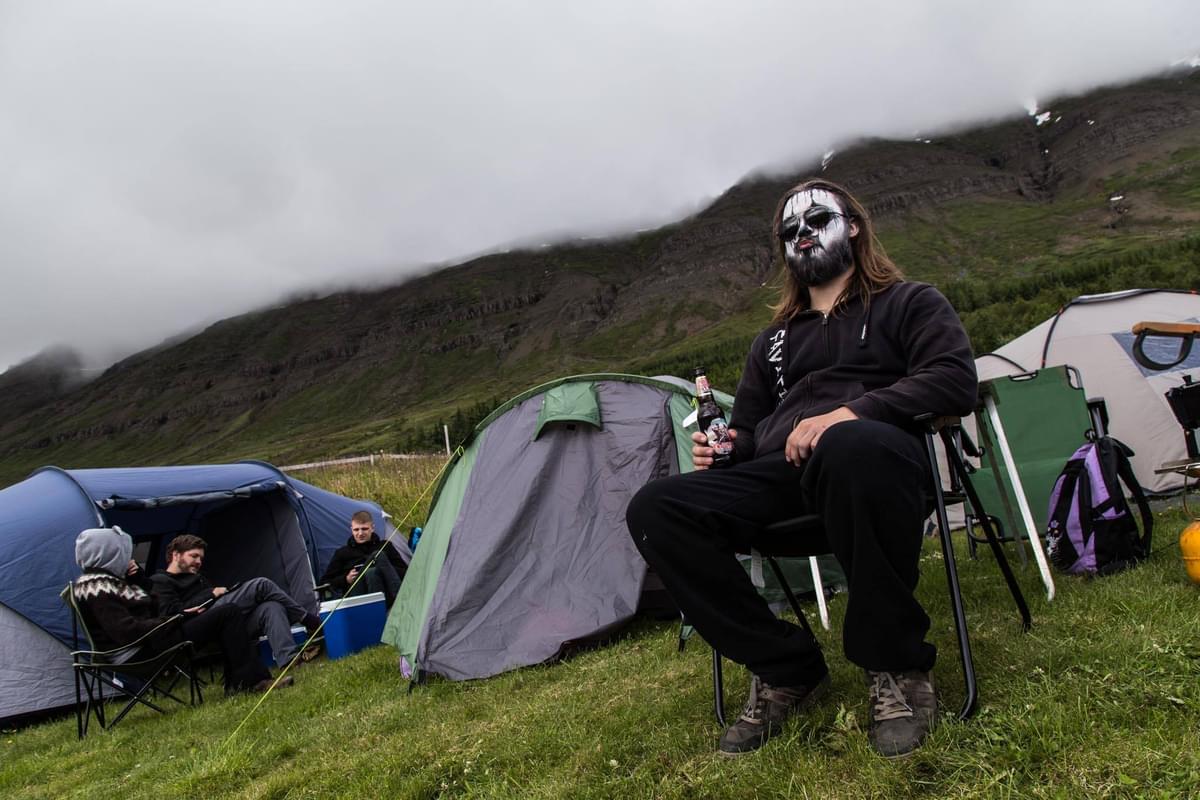
Making friends at Iceland's biggest metal festival
With one last strike of my makeshift hammer, my tent is pitched and I sink into my camping chair with a beer in hand. I’m in a deep fjord, surrounded by towering mountains on all sides. The air is crisp; a gentle fog rolls over the peaks, and even though it is past ten o’clock, the sky is still lit up by Iceland’s midnight sun.
I’m in Neskaupstaður, the easternmost settlement of Iceland, at the country’s biggest metal festival, Eistnaflug. The normally quiet fishing town is home to 1,500 and used to be called “Little Moscow” in days past for its strong communist leanings; although the political aspirations faded with time, the rebel spirit is alive and well in Eistnaflug.
Just getting to Eistnaflug is an adventure in itself. Being located so far east, it is about as far from the capital as you can get. You can opt to fly there, which takes about one hour on the plane and another on the bus, but the twelve-hour road trip is absolutely worth it if you can spare the time. On the way you will encounter tall waterfalls, mountain passes, green fields, rolling hills, glacier lakes, and more.
The festival’s name roughly translates as “Flight of the Testes,” and is home to the heavier kind of counter culter that’s been festering under Iceland’s pristine and graceful exterior. Rock, metal, punk and hardcore all have their home here, and for fans of those genres Eistnaflug is an unmissable annual gathering.
Having gone four times to the festival already, it’s becoming easier to spot who is new then who isn’t. My tent is pitched next to a few friends, and I can hear more friends a few yards away. On the festival grounds I keep bumping into familiar faces, who in turn introduce me to their friends. Singer of seminal Icelandic metalcore outfit Celestine ended his band’s set by echoing this sentiment, saying he felt like he knew everyone in the audience.

Subverting expectations
Given metalheads’ reputation for being dangerous, burning churches, and ties to white supremacy, it might make the idea of 3,000 such individuals descending upon the gentle town of Neskaupstaður sound terrifying. In reality, however, it is anything but.
From its inception in 2005, Eistnaflug’s motto has been “no idiots allowed,” with organiser Stefán Magnússon promising to not hold the festival again if someone gets brutalised or sexually assaulted. Icelandic metal bands, much like the local pagan society, have rejected and distanced themselves from right wing extremists that plague the scene in mainland Europe, making skinheads the outliers of the scene instead of the core of it.
Trouble seems to be the last thing people expect from Eistnaflug; indeed, the corpse-painted and leather-clad attendees get nothing but smiles from the locals as they shop at the supermarket, grab a hot cuppa at the gas station, and frolic in between shows. It is apparent that those gathered are just there to see the bands and have a good time.
This wave of positivity and enthusiasm directly translates to better shows for everyone involved. Smaller bands that have only ever played to audiences of ten or twenty suddenly have hundreds chanting along to their songs, pumping their fists in the air and taking every opportunity to mosh. Dark EDM artist Pertubator found his show swamped with sweaty headbangers, and apologised for not bringing any merch with him as he didn’t think anyone would come to his set.
Bigger bands feed off of this passion, and are urged to even greater heights. Agent Fresco singer Arnór Dan confesses on stage that he’s got a case of pneumonia, but got second wind from Eistnaflug’s intense energy.
And then, because of the festival’s popularity, epic acts like Opeth (pictured below), Meshuggah and Amorphis that would’ve been difficult to get to this small island in the North Atlantic get to shine in front of dedicated fans.
That popularity, unfortunately, comes at a cost.

Evolution of Eistnaflug
Eistnaflug began with Magnússon inviting a few of his friends to come to Neskaupstaður, where he worked as a gym teacher, to play a few shows. Each year more friends were invited, and soon it grew to the point of necessitating ticket sales. The community that formed around the fest was tight nit and cared a lot about this oasis of theirs.
Three years ago several bands confided in me that they feared the festival would become larger and more mainstream, that it would lose its charm.
The art festival and off-venue Mayhemisphere, which saw bands perform in an old and decaying steel factory that had paint peeling off the walls and gaping holes in the floor, did not make a return this year after the factory was decommissioned, and with it disappeared a lot of the grittiness of Eistnaflug. Now food trucks pop up offering festival food at inflated festival prices.

That’s not to say that it is the end times—far from it, it’s just a different chapter for the fest. Although everything is cleaner, and the market forces are more apparent, the regulars haven’t been pushed away. The sense of comradery is still there, and newcomers are just as welcome as ever so long as they follow the rules.
The conferences this year are also particularly interesting, with topics like women in metal being explored in earnest, and existential questions about the metal genre and counter culture getting asked.
There is a cost to this new expansion, but by all accounts it seems to be a cost the fans are willing to pay. On the drive back I had a very real sense of dread at the thought of having to wait another year to go back to Eistnaflug. I hope to see you there.
Get the Best Fit take on the week in music direct to your inbox every Friday

Lorde
Virgin

OSKA
Refined Believer

Tropical F*ck Storm
Fairyland Codex




